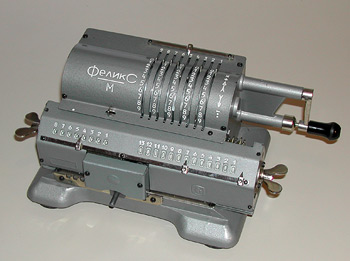 |
|
|
|

|

|
"Iron Felix" meets the Odhner calculator |
|
|
|
|
If you look up “Iron Felix” in Wikipedia, you will see three definitions, representing (a) the infamous Felix Edmundovich Dzerzhinsky, founder of the Cheka secret police, (b) the infamous statue of said Felix that stood in Lubyanka square in Moscow until it went with the regime that erected it, and (c) a mechanical pinwheel calculator named after the aforementioned man. Now, (b) and (a) go well together; you’d expect the founder of what became the KGB to have his statue in front of his organization’s HQ. But a calculator??... |
|
|
|
When I got a "Felix M" model in perfect shape, I was eager to compare it to its Swedish relative, an "Original Odhner" I've had for some time. The two are almost identical in their layout and function, as can be seen in the photo below; I was curious to see how similar they are inside. |
|
|
|
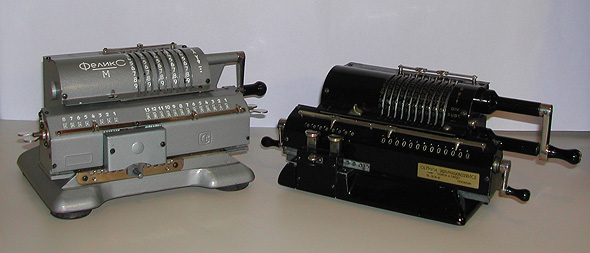 Click photo to enlarge |
|
|
|
With the covers off, we can see that the soviets had taken some liberties in order to attain a machine that is simpler and cheaper to manufacture. They kept the basic pinwheel mechanism, but dispensed with some of the refinements. For example, the mechanism that prevents one from reversing the crank’s rotation in mid-turn is simply missing, as is the one-handed zeroing button for the input register. Manufacturing techniques were also simplified: some screws are replaced with rivets; the numbers on the exterior are punched rather than embossed; the windows for the readout digits are stark flat rectangles, where the Swedes had used rounded openings. |
|
|
|
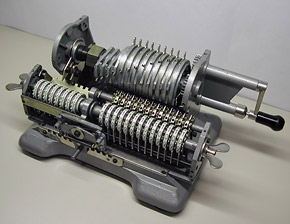
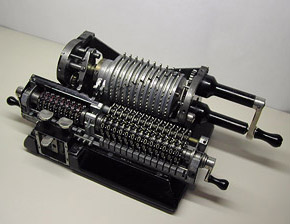 Click a photo to enlarge |
|
|
|
More crucially, in many parts the Russians had used zinc alloy to replace
steel and brass; their machine is much lighter but not as sturdy. The outcome of all these
compromises is a calculator with the same four-function capability but less reliability;
indeed, the looser manufacturing tolerance of the Felix’s gear trains shows up
in a perceptibly larger free play of the mechanism. Below we see the one area where the soviet engineers had implemented their own solution, diverging from the Odhner line. This is the carriage advance control, shown with its cover off for both machines. They are quite different, as you can see: the Felix, at the left, has the mechanism moving with the carriage, and actuated by a sidewise pressure, whereas the Odhner's is fixed to the base and uses downward pushes on the keys. Both companies remained loyal to their chosen version through many decades of refinement and production. |
|
|
|
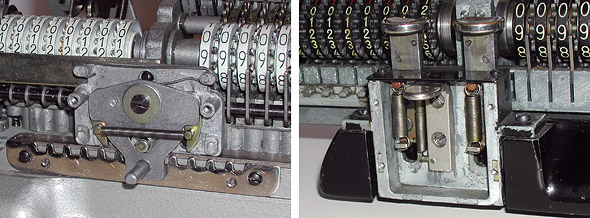 Click photo to enlarge |
|
|
|
Iron Felix (the man, not the machine) was a cruel person, but he was not a fool; he realized all too well that in a struggling new economy lacking free competition and customer complaint hotlines he could afford to let his engineers drop a few features as long as they came up with a no-nonsense, mass-produced machine. This is often seen in the technology of young nations. And in this respect, the Iron Felix (the machine, not the man) was quite successful: it was used for over half a century throughout the Soviet Union. Indeed, one can surmise that Felix calculators were put to good use in the effort that put an equally no-frills artificial moon into orbit in 1957 -– this time ahead of the competition. |
|
|
|
Exhibit provenance: This was a welcome gift from my good friend Moshe Kigler.
More info: |
|
|
|
|
|
|
|
Home | HOC | Fractals | Miscellany | About | Contact Copyright © 2005 N. Zeldes. All rights reserved. |
|
